While chemotherapy is often administered, we believe that boosting the immune system can improve overall health, maintain quality of life (QOL), and restore energy and appetite. There are numerous cases where immune support with Cordy has successfully helped control cancer in dogs.
Please do not despair if your beloved dog is diagnosed with a mammary tumor. This page provides an overview of the characteristics, treatments, and ways to improve the prognosis of mammary tumors (breast cancer). Numerous cases of improvement are also introduced. We hope to offer you support and light in your journey.
目次
What are Mammary Tumors in Dogs?
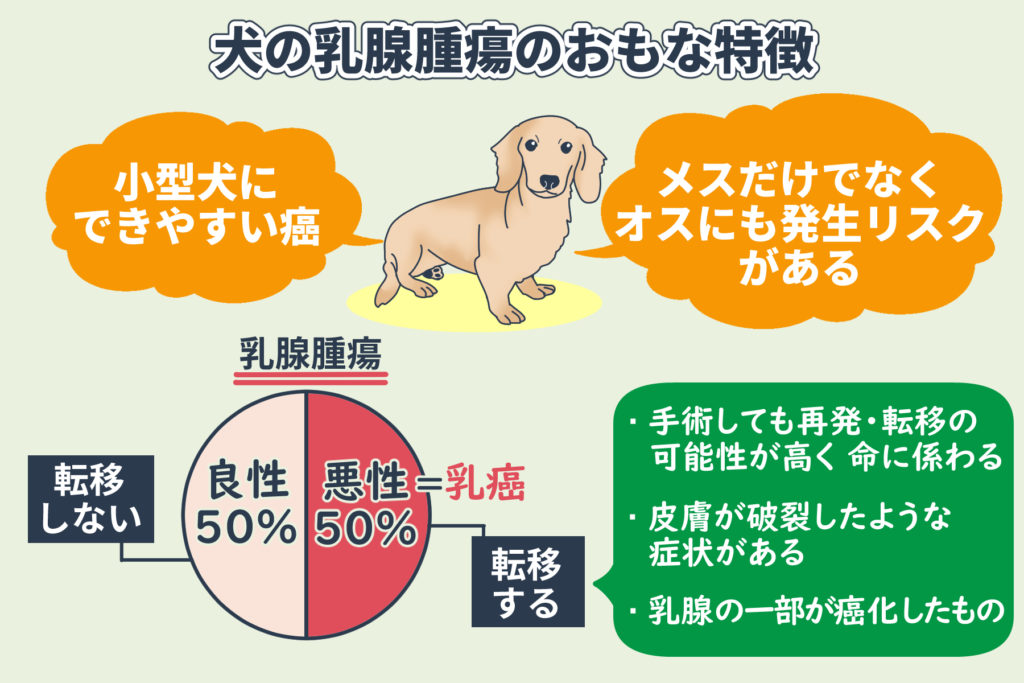
They do not exclusively occur in female dogs; they can rarely develop in male dogs as well.
Malignant mammary tumors are commonly referred to as breast cancer. Malignant tumors often recur or metastasize even after surgery, posing a significant danger to dogs. Additionally, the skin may rupture and ulcerate.
Dogs have ten mammary glands in total, five pairs extending from the chest to the abdomen, and a malignant tumor can develop in any of these glands.
Are Mammary Tumors Malignant or Benign?
Approximately 50% are malignant.
The major distinction between benign and malignant mammary tumors is whether they metastasize. Benign mammary tumors do not metastasize.
In contrast, malignant mammary tumors metastasize to lymph nodes, lungs, abdomen, liver, and can also rupture and ulcerate.
Malignant mammary tumors are life-threatening diseases.
Striving for Complete Recovery and Coexistence with Mammary Tumors
Early detection is crucial, but creating an environment that minimizes the risk of cancer and supporting the immune system plays an essential role in cancer prevention.
If the immune system functions properly and the balance of hormones and the autonomic nervous system is maintained, it becomes significantly harder for cancer cells to proliferate and form into noticeable breast cancer.
Even if a dog is already diagnosed with cancer, understanding the causes of breast cancer and addressing these causes can help in creating an environment where the cancer does not grow or metastasize easily.
When your beloved dog is diagnosed with a mammary tumor, many of you may feel devastated and at a loss. I completely understand your worry. However, a mammary tumor does not equate to death.
First and foremost, it is crucial for the owner to learn the correct knowledge about malignant mammary tumors (breast cancer) in dogs. Let’s study together for the sake of your beloved pet.
What is Malignant Mammary Tumor (Breast Cancer) in Dogs?
Overview of Mammary Tumors
Malignant mammary tumors (hereafter referred to as mammary tumors) in dogs are highly prevalent cancers.
 Mammary tumors have been increasing due to the longer lifespans of dogs. As dogs age, their immune systems weaken significantly, particularly during the senior years, making them more susceptible to mammary tumors.
Mammary tumors have been increasing due to the longer lifespans of dogs. As dogs age, their immune systems weaken significantly, particularly during the senior years, making them more susceptible to mammary tumors.
Mammary tumors are frequently found in unspayed female dogs but are rarely seen in male dogs.
Early spaying drastically lowers the incidence of such tumors, which is one rationale behind recommending spaying surgeries.
Mammary tumors are very prone to recurrence and are extremely “malignant” cancers.
Thus, veterinarians do not believe that “removing it once means it’s all over.”
We often hear about cases stuck in a cycle of cutting the tumor out and its subsequent recurrence, akin to a game of “whack-a-mole.”
This approach is based on the idea that “recurrence happens because the mammary gland exists. Therefore, let’s remove all healthy mammary tissues to prevent future cancer.”
However, even after extensive removal of the entire mammary gland area, cases of recurrence continue to surface.
The dangers of mammary tumors do not end there.
Mammary tumors frequently metastasize to the lungs.
When metastasis to the lungs occurs, it impairs lung function, causing respiratory distress that gradually or rapidly saps the dog’s vitality.
Particularly Malignant Inflammatory Breast Cancer
When it develops, severe inflammation causing great pain is observed in the mammary gland.
The mammary gland may become hot, red, and swollen, sometimes even rupturing.
It is highly malignant and grows rapidly.
Instead of forming lumps, it spreads around the skin through infiltration.
Although rare, accounting for less than 10% of all mammary tumors in dogs, it easily metastasizes to the lymph nodes and lungs. Thus, the prognosis is extremely poor, and it is a tumor for which surgery alone is difficult to achieve a cure.
For managing self-dissolving mammary tumors, there is a liquid-cultured Cordy solution available, and there have been cases where the self-dissolved areas have returned to healthy skin. You might want to consider trying it.
Which dog breeds and ages are prone to mammary tumors?
- Poodle
- Chihuahua
- Yorkshire Terrier
- Miniature Dachshund
- Other small breeds
Additionally, it is often observed not in young dogs, but in middle-aged to older dogs.
As immunity tends to decrease with age, creating an environment where the immune system can function properly and providing supplements is important.
Understanding mammary tumors and starting preventive measures
I apologize for highlighting only the dangers of mammary tumors from the beginning, but there are many unsprayed dogs that do not develop the tumors, and many that never experience a recurrence after surgery.
For those of you reading this page, it might be because your beloved pet, a member of your family, has a suspected mammary tumor, or is suffering from one, or has already been diagnosed with a mammary tumor and undergone surgery or chemotherapy.
I want to let you know that even with highly malignant or aggressive mammary tumors, it is possible to slow down cancer progression and coexist with cancer depending on your efforts. You can alleviate your dog’s suffering and improve their quality of life (QOL).
The rate is largely influenced by daily habits. I hope this page helps you find appropriate preventive measures for your dog.
Here is an important suggestion.
If you have been giving your dog dairy products, please start reducing them from today.
We believe continuous consumption of dairy products promotes the growth of mammary tumors. More details will be provided later.
- Cases of improvement in self-dissolved late-stage mammary tumors in dogs with Cordy
- Case of mammary tumor improvement in a Maltese with decreased kidney function
- Case of surgery and recovery in a 17-year-old mixed breed dog with self-dissolved mammary tumors
- Case Study: Tumor Shrinkage in a 17-Year-Old Mixed Breed Dog with Mammary Tumors After Administering Cordy
- Case Study: Improved Immunity and Quality of Life (QOL) in a Cat with Terminal Mammary Tumors
Nature of Mammary Tumors
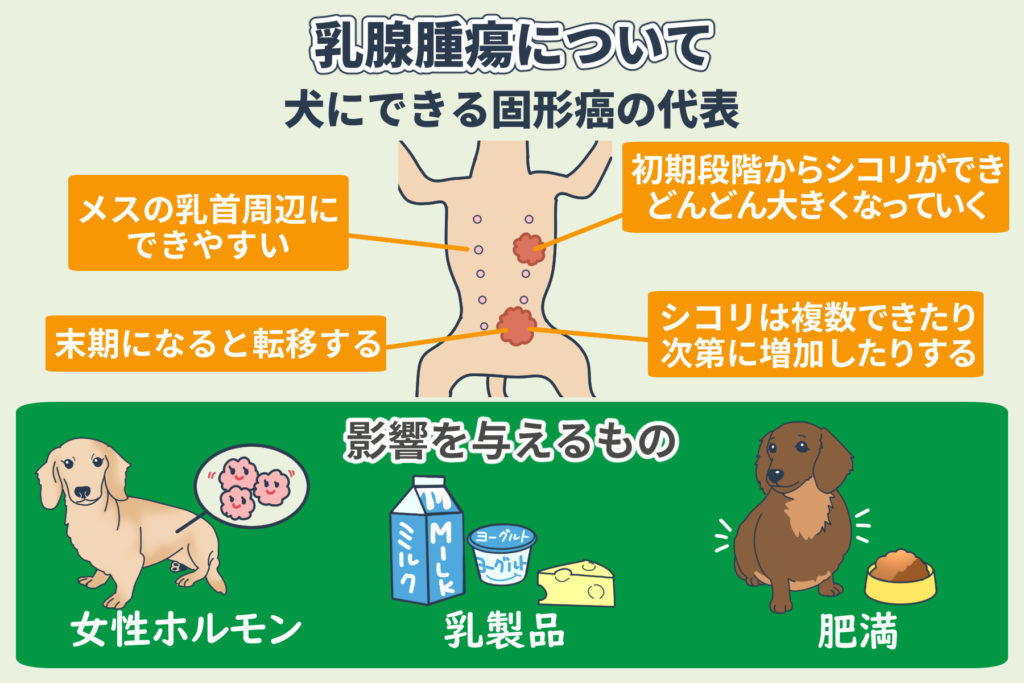
They primarily develop around the nipples of female dogs and form lumps that can be felt relatively early in their development.
These lumps gradually enlarge and eventually become noticeable without palpation.
While some dogs may develop just a single lump, multiple lumps can occur or increase in number over time.
Mammary tumors, despite being solid cancers, tend to metastasize easily.
In cases of terminal mammary tumors, lymph node metastasis and lung metastasis are frequently observed.
Lung metastasis is one of the most concerning progression patterns of mammary tumors.
Association with Female Hormones
It is believed that female hormones have a significant impact on mammary tumors.
Spaying at a young age reduces the likelihood of developing mammary tumors because the removal of the ovaries decreases the amount of female hormones in the body, thereby suppressing mammary gland growth.
It is a well-known fact that female hormones promote the growth of mammary glands.
For instance, it is widely recognized that continuous administration of female hormone agents in humans causes breast enlargement.
If a tumor is present in the mammary glands at that time, it will also grow and proliferate.
Be cautious as female hormones can also be ingested through diet.
Additionally, dietary imbalances can increase the endogenous production of female hormones, so please be mindful of this as well.
Let me explain with some examples.
Reduce Dairy Intake as Much as Possible
In humans, there is a strong correlation between diet and breast cancer.
It is likely the same for dogs.
For instance, the incidence of breast cancer in Japanese women is lower compared to Western women, which is thought to be influenced by dietary factors.
This indicates that breast cancer is more strongly influenced by environmental factors than genetic ones.
Among various foods, dairy products are believed to be deeply connected to the development of breast cancer.
It is publicly known that milk contains female hormones.
If your dog is female, it is recommended to avoid milk. Yogurt and cheese made from milk are also not recommended.
The Risk of Obesity
This also applies to humans, but research has shown that obesity after menopause promotes the development of breast cancer.
Consider menopause equivalent to “spaying surgery” in dogs.
It is common to think that the absence of ovaries stops the secretion of female hormones, but in reality, female hormones are also secreted from fat cells.
In obese dogs, meaning those with a high number of fat cells, the risk is believed to increase.
The primary cause of obesity is diet. “An apple a day keeps the doctor away” could also apply to dogs.
If their regular diet can reduce the incidence of mammary tumors, then it would be worthwhile to reconsider their diet.
Excessive calorie intake and diets high in sugar can easily lead to obesity, so please be careful.
Dog foods that use a lot of grains and potatoes, white rice, brown rice, bread, and udon can skew the diet balance toward high sugar content.
Symptoms of Mammary Tumors
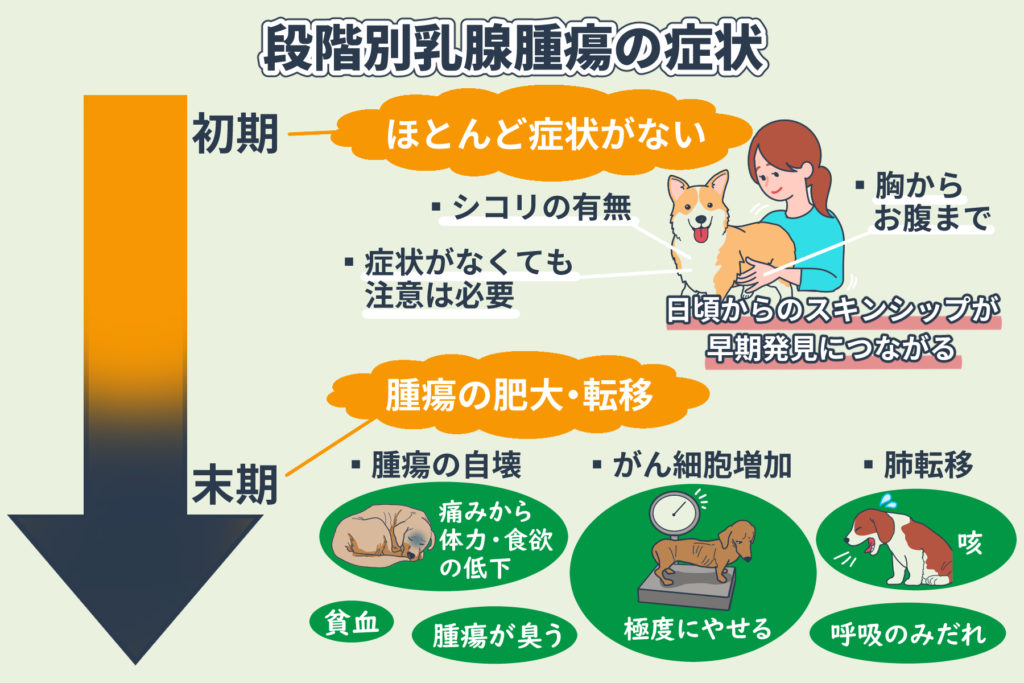
Early Symptoms
Symptoms appear only after the disease has progressed considerably.
Therefore, discovering a lump near the mammary glands and assuming there is no problem because there are no other symptoms is not advisable.
Mammary tumors develop under the skin, making them hard to detect visually, but you might notice them by touch.
To detect them early, regularly engage in physical contact with your dog, checking for lumps near the mammary glands with your fingertips.
If your dog is female, occasionally rub from her chest to her belly and check for abnormalities.
Sometimes groomers or veterinarians may detect them first.
Choosing an experienced groomer or veterinarian can lead to early detection.
Advanced Symptoms
In advanced mammary tumors where the tumor has become large or has metastasized to the lungs, various symptoms can appear. Here are some examples:
- Symptoms due to tumor necrosis (bursting) … Decreased energy and appetite caused by pain. Anemia symptoms due to bleeding. Foul odor from the tumor.
- Symptoms due to an increase in cancer cells … Extreme weight loss as the large number of cancer cells start using muscle and fat as energy sources (cancer cachexia).
- Symptoms due to lung metastasis … Increased coughing. Rapid or labored breathing.
If you notice any of these symptoms in your dog, please consult with a veterinarian as soon as possible.
Additionally, if you summarize your pet’s usual behavior and any abnormalities in a memo before the visit, it will help prevent forgetting crucial information.
About Cancer Cachexia
It arises because the toxins (such as cytokines) released by cancer cells disrupt the body’s normal functions.
In cases of cachexia, nutritional status worsens, and physical strength continuously deteriorates. Even with adequate food intake, muscle mass decreases, and noticeable weight loss occurs.
A lack of calorie intake is not the fundamental cause, so addressing it with large amounts of glucose drips is not recommended as a solution. Sometimes, symptoms improve after surgery reduces the number of cancer cells by removing a tumor.
However, if your pet does not have enough strength to withstand surgery, there are risks involved, so be sure to consult with your veterinarian thoroughly.
How to Differentiate from Benign Mammary Tumors
Benign tumors can also form lumps, making it often difficult to distinguish by appearance alone.
Since it is challenging for owners to determine if a tumor is benign or malignant, we recommend early examination through a biopsy.
Lumps that don’t disappear might be best removed through surgery, including for examination purposes.
If it is certainly benign, laser ablation to vaporize it is also an option.
Even benign tumors can grow large and cause severe conditions.
The following symptoms are indicative of malignancy. Use them as a guide.
- Adjacent to the nipple
- Located under the skin with a hard texture
- Larger than 1 cm
- Sudden growth
- Central depression of the tumor
- Ulceration (skin rupture)
- Rough or irregular shape
- Presence of lumps near the base of the front or hind legs
- Occasional difficulty breathing or coughing
- Decline in strength or weight loss
- Extensive inflammation of the abdominal skin
Regarding Central Depression
One cause is the insufficient blood supply relative to the tumor’s size.
As the tumor grows, the center increasingly becomes a low-nutrition and low-oxygen area, while the peripheral parts receive sufficient supply.
As a result, the lump may take on a concave shape. *Note that convex shapes do not guarantee it is benign.
Regarding Ulceration
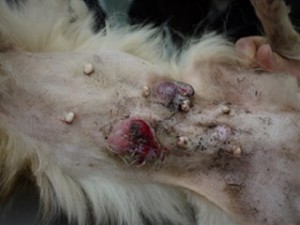 As mammary tumors grow, they can split open, leading the stretched skin to rupture.
As mammary tumors grow, they can split open, leading the stretched skin to rupture.
Blood-tainted body fluids can start oozing out, and anemia and pain may rapidly worsen the condition.
**There may be a foul odor from necrotic tumors,** and one reason is that **the necrotic central part becomes exposed.**
If flies attracted by the foul odor lay eggs, the affected area will worsen further.
### Lump in the Groin Area
The mammary glands are connected by lymphatic vessels, through which cancer cells travel.
There are lymph nodes in the groin, which can be considered checkpoints of the lymphatic vessels. Cancer cells are temporarily halted there.
When cancer cells proliferate in these lymph nodes, forming lumps, it is referred to as lymph node metastasis. Since the lymph nodes in the groin are close to the body surface, you can check for lumps by palpation.
### Presence of Cough
Malignant mammary tumors are carcinomas that easily metastasize to the lungs. Even if there is lung metastasis, a cough does not always occur; however, a persistent cough is dangerous and could indicate terminal symptoms.
### Broad Abdominal Inflammation
**If there is dermatitis not only around the cancer but also over a wide area, inflammatory breast cancer is suspected.**
Inflammatory breast cancer is a very poor prognosis type of mammary tumor and is considered the most dangerous carcinoma in current veterinary medicine, as it is deemed incurable.
## Tests at Veterinary Hospitals
There are specific testing methods depending on the purpose.
- Preliminary tests to make a rough diagnosis are conducted to establish a general treatment direction.
- Tests for a definitive diagnosis are crucial for determining whether the mammary tumor is benign or malignant.
- Tests to check for metastasis help in establishing a treatment plan before surgery and in detecting recurrence or metastasis early after surgery.
### Accuracy of Tests
**No type of test can be 100% accurate.**
Combining multiple tests, medical interviews, visual examinations, and physical examinations is necessary to improve testing accuracy.
Therefore, the accuracy of tests can vary greatly depending on the hospital’s equipment and the veterinarian’s experience and skill. Experience is especially crucial.
### Preliminary Testing – Cytology
If the test result is benign, a compact excision surgery may suffice, or surgery may be postponed. Conversely, if the result is malignant, further testing with a histological examination may be needed, or a proposal for extensive surgery may be made.
Cytology has a relatively low accuracy rate, meaning false negatives are common. This is because cells might be extracted from a region without cancer cells.
Thus, cytology alone is not a definitive diagnostic method for mammary tumors.
While it might be unheard of for humans, in the case of dogs, it is common practice to remove the mammary glands even if the malignancy is not confirmed, due to different aesthetic considerations.
### Tests for Definitive Diagnosis – Histopathology
By surgically removing and examining a tumor, you can obtain a wealth of information such as the type of tumor, degree of malignancy, and its spread.
Histopathological examination is considered the most accurate method for diagnosing mammary tumors, and a definitive diagnosis is made based on the test results. Additionally, it is possible to determine the malignancy from the degree of internal structural disruption.
Since tumor removal is necessary, general anesthesia is required, which entails a certain level of risk and tissue damage.
If the examination and surgery are performed separately, general anesthesia will be required twice. Therefore, it is common to proceed with surgical removal first, and then perform a definitive diagnosis using the excised tissue.
Tests to Check for Metastasis – X-ray
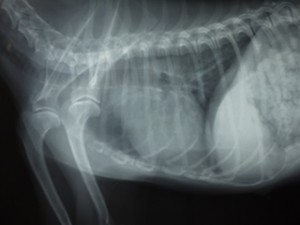 X-ray examination does not require general anesthesia and allows relatively easy and wide-ranging examination of the body’s interior. It is used to detect tumors located in deep areas that cannot be palpated.
X-ray examination does not require general anesthesia and allows relatively easy and wide-ranging examination of the body’s interior. It is used to detect tumors located in deep areas that cannot be palpated.
In the case of mammary tumors, its primary purpose is to check for lung metastasis.
Pre-treatment X-ray examination is important.
If lung metastasis is found, complete recovery is unlikely even if all the mammary glands are removed.
In such cases, it is advisable to either forgo the surgery or limit it to a smaller scale, so please consult your veterinarian thoroughly.
More Detailed Metastasis Examination – CT Imaging
CT scans produce tomographic images that allow more detailed observation of the body’s interior compared to X-rays. The examination range is extensive.
It can detect small tumors that might be missed by X-rays, but it cannot determine if they are cancerous masses. The need for general anesthesia, the high radiation exposure, and the high cost are considered drawbacks. Therefore, if X-rays are sufficient, a CT scan might not be necessary.
Detailed Tumor Imaging – MRI Imaging
MRI also requires general anesthesia and is expensive, similar to CT scans.
It is useful for more precise surgeries, but MRI is not necessary for routine mammary or lymph node removal. If there is a possibility of brain metastasis, considering MRI could be appropriate.
- A case where Cordy was administered and improved a terminal mammary tumor in a dog.
- Case example ③ of Improvement in a dog with mammary tumors (Maltese with decreased renal function)
- A 17-year-old mixed breed dog with a self-destructed mammary tumor was able to undergo surgery and live healthily.
- A Case Where a 17-Year-Old Mixed Breed Dog’s Mammary Tumor Shrunk After Being Given Cordy
- A Case Where a Cat with Advanced Mammary Tumor Showed Improved Immunity and Quality of Life
General Treatments
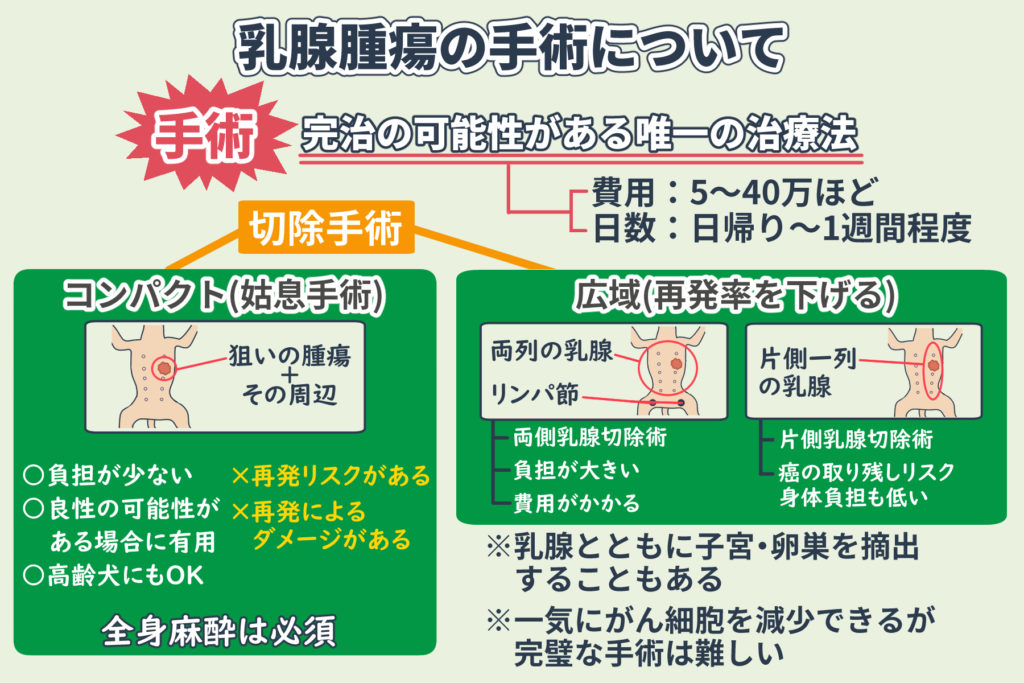
Surgery
Surgery can quickly and significantly reduce cancer cells. If you are lucky, it is possible to remove almost all cancer cells.
However, it is common to leave a small amount of cancer cells behind, and perfect surgery is often challenging.
There are several options for surgical methods.
Compact Excision Surgery
This has the nuance of a partial resection or reduction surgery in human terms.
When aiming to partially remove the tumor rather than curing it completely, it has a palliative (alleviating) surgery nuance.
The targeted tumor and a small area around it are excised.
Compared to wide excision mentioned later, this surgery is quite compact and less burdensome for the dog.
The recurrence rate post-surgery is high, but it is useful when the possibility of benign tumor is high or for elderly dogs that cannot handle major surgery.
However, general anesthesia is still necessary.
There is a risk of leaving cancer behind and facing repeated recurrences, ultimately causing substantial damage.
Sometimes, a compact removal of only the tumor is performed to obtain a biopsy sample.
Wide Excision Surgery
Surgery that removes as wide an area as possible is said to reduce the recurrence rate and is more common than compact surgery.
With wide excision surgery, mammary glands that haven’t yet developed cancer are also removed.
How wide to cut depends on the policy of the animal hospital.
There is surgery that stops at removing the adjacent mammary glands, surgery that removes an entire row of mammary glands on one side, and the most extensive surgery removes all mammary glands on both sides and the regional lymph nodes near the fore and hind legs.
Bilateral Mastectomy involves wide excision of mammary glands on both sides. Though it puts a heavy burden on the body and is costly, it is chosen when there are repeated recurrences or multiple occurrences (several cancers present).
Unilateral Mastectomy is surgery that removes all mammary glands in one row on either the left or right side.
The risk of leaving cancer behind is relatively low, and the burden on the body is less than bilateral excision.
Hysterectomy and Oophorectomy
It is sometimes performed simultaneously with the removal of mammary glands.
The aim is to reduce the supply of female hormones to prevent recurrence.
Cost of Surgery and Hospitalization Period
As mentioned above, there are various methods of mammary tumor surgery, and the costs and length of hospitalization differ depending on whether it’s a day surgery or a small-scale operation.
The difficulty of surgery also varies based on the state of the cancer.
Therefore, surgical fees and hospitalization periods vary for each case. Generally, the cost ranges from 50,000 to 400,000 yen, with hospitalization ranging from a day to about a week.
Anticancer Drug Therapy (Chemotherapy)
Mammary tumors are generally not very responsive to chemotherapy. It is extremely rare for chemotherapy to completely cure such tumors. If used, the aim is primarily to prevent recurrence after surgery.
As mentioned earlier, surgery often leaves behind a small number of cancer cells, and chemotherapy is administered under the justification of eradicating those remaining cancer cells.
However, how beneficial is chemotherapy for the purpose of preventing recurrence? I will provide some examples, and I encourage everyone to think about it together.
Benefits of Chemotherapy
However, the probability of experiencing some side effects is almost 100%.
When used for mammary tumors with a recurrence rate of 60%, reducing this by 10% means a reduction of 6% (bringing the recurrence rate to 54%).
At first glance, this may not seem bad, but please read on carefully.
While it might seem inappropriate to evaluate chemotherapy purely in terms of profit and loss, I want to consider whether undergoing this treatment is more beneficial or detrimental for your dog to help you understand better.
If doing nothing after surgery means there’s a 60% chance of recurrence, it also means that 40% of the dogs won’t experience a recurrence even without chemotherapy.
These 40% of dogs wouldn’t have had a recurrence without chemotherapy, so if they undergo chemotherapy after surgery, their bodies will be damaged by side effects, and in some cases, these side effects could significantly shorten their lives.
Therefore, if chemotherapy is applied to these dogs who wouldn’t have experienced a recurrence anyway, it results in a clear “loss.”
If a recurrence occurs, the treatment continues with a different type of chemotherapy, extending the period the dog suffers from chemotherapy side effects.
Hence, for the 54% of dogs for whom chemotherapy failed to prevent recurrence, the treatment resulted in significant “loss” despite the effort.
Even with rough calculations, it appears that for 94% of the dogs, chemotherapy results more in “loss” than “gain”.
Chemotherapy is akin to a gamble in that you won’t know if it works until you try it.
Therefore, before starting chemotherapy, I urge the entire family to consider thoroughly whether your dog needs chemotherapy, taking into account the dog’s age, physical strength, and the state of the cancer.
If the dog is currently undergoing chemotherapy, closely monitor whether the side effects are reducing the dog’s overall energy and appetite, and whether the chemotherapy’s benefits outweigh these side effects. If the treatment is proving insufficient, thoroughly consider whether continuing chemotherapy will be beneficial for your dog.
Note that chemotherapy poses risks not only to dogs but also to humans.
For details on these risks, please refer to the next page: Minor Exposure to Chemotherapy—Be Cautious During Your Pet’s Cancer Treatment
Radiation Therapy
Most animal hospitals do not have equipment for radiation therapy, so it is not a common treatment that can be received anywhere.
There are very few cases where radiation therapy is used alone for treatment. More commonly, radiation therapy is employed with the aim of reducing recurrence after surgery as much as possible.
Unlike human radiation therapy, dogs receive high doses of radiation in fewer sessions. As a result, the incidence of side effects is likely to be higher.
Knowledge and Ideas for Managing Mammary Tumors
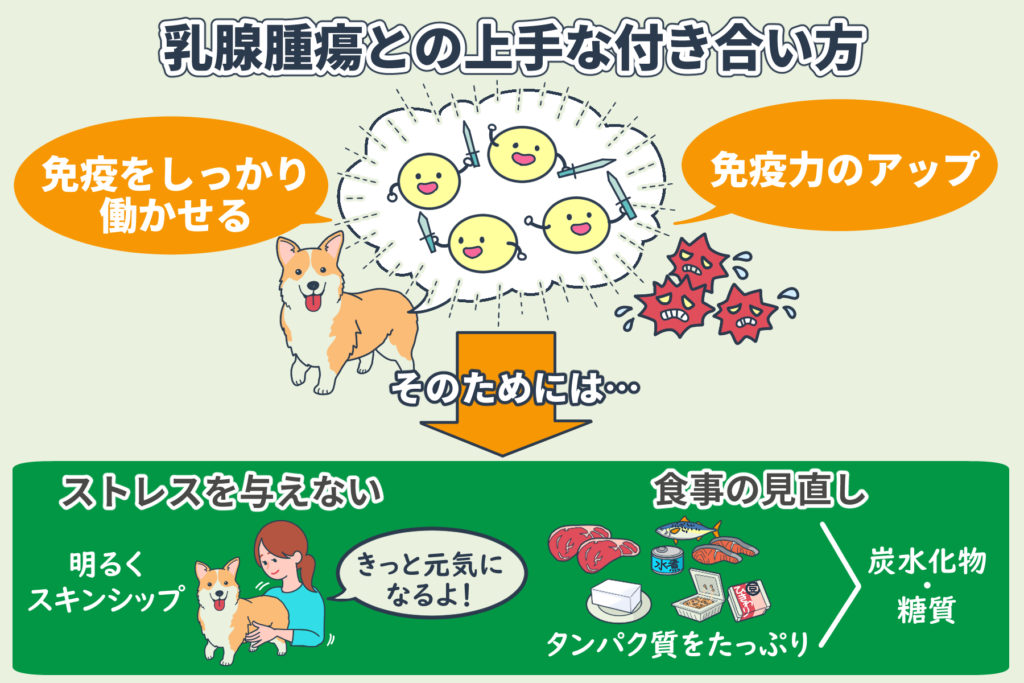
The Role of Immunity in Reducing Incidence and Recurrence Rates
The key to lowering the incidence and recurrence rates is not conventional Western medical treatments. What is significantly more important is understanding the relationship between cancer and immunity, and enhancing immune function. The most efficient way to suppress the proliferation of cancer cells is through the immune system.
The Role of Immunity in Suppressing Cancer
Even in a healthy body, cancer cells exist. Amazingly, hundreds to thousands of cancer cells are generated daily.
However, if the immune system is functioning correctly, these cancer cells which emerge daily are destroyed entirely, preventing their proliferation.
The immune system operates within our bodies without us being consciously aware, detecting, attacking, and destroying cancer cells. Because of this, we do not need to take anticancer drugs for cancer prevention.
As long as the immune system is functioning normally, developing cancer is not easy. Conversely, if there are abnormalities in the immune system, the risk of developing cancer increases.
If cancer cells arise but the immune system fails to detect or has insufficient ability to attack them, cancer proliferates, leading to tumor growth.
Efforts to Enhance Immunity
The activity level of the immune system can fluctuate based on minor factors.
For example, mental state significantly influences immunity. Stressors that activate the sympathetic nervous system, such as irritation, anxiety, and fear, suppress immune function.
Dogs observe their owners’ facial expressions closely.
In contrast, immunity activity increases when relaxed. Effective physical contact that relaxes your dog can become a significant treatment, enhancing the effect of any medical treatment received.
Saying supportive words like “This treatment works well” and “You will certainly get better” is important.
Some might dismiss this as a placebo effect, but there’s a longstanding saying, “Illness starts from the mind,” which many people find relatable.
There are individuals who attempt to ward off illness with laughter, which is actually a rational approach. They understand well the means to control immunity. Please consider this knowledge as a useful reference.
You don’t need to laugh out loud, but at least always interact with your dog cheerfully.
Additionally, provide good food and nutrition, as well as quality supplements. Gut health is also important as it may enhance immune function. If you firmly believe that dog food is the best diet for your dog, you might miss out on opportunities to boost their immunity. Try the food items suggested on this website.
Recommended Diet for Dogs with Mammary Tumors
Revising your dog’s diet can lead to an improvement in their constitution and aid in better recovery outcomes.
To maintain your dog’s immune system, first re-evaluate their daily diet.
The goal of dietary therapy is to slow down cancer growth, build strength, and improve conditions such as anemia and albumin levels. At our company, we place a high emphasis on a nutritional approach as the foundation of treatment.
Cancer needs carbohydrates (glucose) to grow.
Therefore, limiting carbohydrates as much as possible is a manageable step that can be taken immediately, with no strain on the body, and no risks of side effects.
However, dietary therapy cannot be conducted without the cooperation of your entire family.
Give ample amounts of protein such as fish, meat, tofu, and natto, and reduce the amount of food that is high in carbohydrates and sugars.
Changing your dog’s diet alone won’t cure cancer, but restricting carbohydrates, essential for the growth of malignant lymphoma, can slow down its progression.
Although it takes more time and effort compared to just giving food, we hope you can start without thinking too hard about it.
Tips for Dietary Therapy
When dealing with malignant lymphoma, it is highly recommended to increase the amount of protein and reduce the amount of carbohydrates.
However, since preparing meals can be challenging and hard to maintain in the long term, we’ve created a list of ingredients to help reduce your burden.
We also have other articles that could provide helpful tips on diet, so please read those as well.
- Cancer Dietary Therapy for Dogs and Cats—The Basics are High Protein, Low Carbohydrate
- New Dietary Ideas to Fight Cancer (For Dogs and Cats)
- Actively Taking Vitamins for Cancer Prevention in Dogs and Cats
- Low-Protein Diet and Kidney Disease in Cats
- Supplementing BCAAs for Dogs and Cats with Fatigue or Liver and Kidney Issues
Consider Immune Support for Your Dog with Mammary Tumors
It might be beneficial to use Cordy for immune support if your dog has mammary tumors (breast cancer).
Our lab receives daily consultations about mammary tumors.
To date, many dogs with mammary tumors have taken Cordy.
- Dog underwent surgery for mammary tumors but they recurred
- Dog is undergoing chemotherapy but has become lethargic
- Dog has been given a terminal diagnosis
Cordy, expected to have immune-modulatory functions, is thought to help with reducing side effects, improving QOL (quality of life), inhibiting tumor growth, and preventing recurrence.
Several cases have been reported where dogs with mammary tumors showed long-term survival or improvement after taking Cordy.
While the exact response may vary, there is a significant possibility that your dog could regain appetite and energy.
Consultation is free. If you have any questions, please feel free to contact us.
Things You Should Do During Treatment
They are a treatment-resistant form of cancer.
Even after undergoing surgery, it is not uncommon for the cancer to recur or metastasize, placing a significant burden on the body.
It is not a type of cancer that responds well to chemotherapy.
It’s not unusual for dogs with low vitality to have to discontinue chemotherapy due to side effects.
While it’s said that dogs do not show as many side effects as humans, is this really true?
Dogs cannot speak and therefore cannot complain about nausea, dizziness, or numbness.
Additionally, the ambiguous normal range of blood test values for dogs might also make side effects appear less severe.
We recommend using Cordy “to help recovery after surgery and reduce the risk of recurrence” and “to enhance the effectiveness of chemotherapy while reducing its side effects.”
This can potentially enhance the innate immunity and natural healing abilities of dogs, allowing them to maintain a better QOL (quality of life).
Younger dogs are more resilient to chemotherapy side effects because they have more physical strength and immunity reserves.
This is not the case for elderly dogs.
When told “your dog has 1-2 months left without treatment,” it is easy to believe that entrusting the veterinary treatment is the only option. But, the owner’s involvement is immensely important.
Your involvement can significantly influence the treatment effect and prognosis.
When told that “your dog will live for six months with chemotherapy or 1-2 months without it,” this only holds if the chemotherapy is highly effective with minimal side effects.
It is advisable to ask your veterinarian whether chemotherapy will certainly extend your dog’s life, whether it will not make your dog lethargic due to side effects, and whether the expected benefits will surely be achieved.
When starting chemotherapy, it is almost certain that physical strength and immune capacity will decline. Therefore, it is essential to consider countermeasures for this.
First, provide a good diet to build strength and prevent dropping out of treatment due to side effects, and ensure that the immune system does not weaken.
Instead of relying solely on chemotherapy, it is important to adopt a comprehensive approach, including dietary adjustments, stress management, and immune support.
Our lab is conducting research to determine whether the administration of Cordy can modulate the immune system and whether it has potential effects on cancer.
If you have any questions, please do not hesitate to contact us.
監修獣医師:林美彩 所属クリニック:chicoどうぶつ診療所

代替療法と西洋医学、両方の動物病院での勤務経験と多数のコルディの臨床経験をもつ。 モノリス在籍時には、一般的な動物医療(西洋医学)だけでは対応が困難な症例に対して多くの相談を受け、免疫の大切さを痛烈に実感する。
ペットたちの健康維持・改善のためには薬に頼った対処療法だけではなく、「普段の生活環境や食事を見直し、自宅でさまざまなケアを取り入れることで免疫力を維持し、病気にならない体づくりを目指していくことが大切である」という考えを提唱し普及活動に従事している。
所属:
- Case in which Cordy was administered to improve a terminal mammary tumor in a dog that ulcerated
- Case of mammary tumor improvement in a dog with deteriorated kidney function (Maltese)
- Case in which a 17-year-old MIX dog with an ulcerated mammary tumor was able to undergo surgery and live healthily
- Case where a 17-year-old MIX dog with a mammary tumor saw tumor reduction with Cordy
- Case where the immune system and quality of life (QOL) of a cat with terminal mammary tumor were improved
- Canine Mammary Tumors (Breast Cancer) – Tumor Testing, Symptoms, Surgery, Treatment, Tips for Improvement and Recovery
- Canine Cancer (Tumors) – Symptoms, Testing, Surgery, Treatment, Diet, Tips for Cancer Improvement and Recovery
- Is it Effective for Benign Mammary Tumors in Dogs?
- List of Articles on Mammary Tumors






